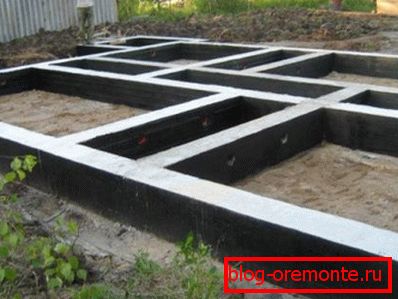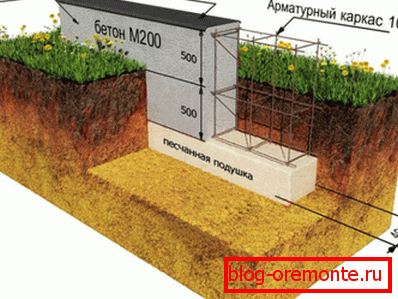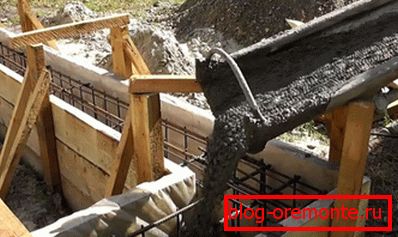The foundation for a house of aerated concrete: the stages
Building a house of aerated concrete has many advantages and one of them is less demanding on the foundation. This is due to the fact that the structure itself has a small weight, respectively, the base takes on less pressure than with traditional construction. Therefore, in most cases it is quite enough to build a shallow-foundation for a house of aerated concrete.

Next, we take a closer look at how to build a foundation for a house of aerated concrete.
Types of foundations
Before proceeding to the construction process itself, consider what foundation is best for aerated concrete house.
There are several options:
- Recessed tape;
- Monolithic plate;
- Bored piles;
- Ribbon shallow.
The most powerful is tape recessed, but at the same time, the price of this design will be the highest. As mentioned above, a house of aerated concrete does not need a powerful foundation. Therefore, the simplest, cheapest and at the same time reliable option is a shallow foundation.
However, it should be borne in mind that the choice of the foundation for a house of aerated concrete depends largely on the geological conditions. For example, if the soil is heaving, then it is better to use a shallow foundation foundation with bored piles and a monolithic grillage.

Tip! When choosing a foundation for a concrete house, you need to follow one important rule - the design must be reliable and provide rigidity to the whole house. The durability and strength of the whole structure depends on how well it is observed.
When choosing the type of base, it is best to seek help from specialists, since it is quite difficult to calculate the structure yourself, and you need to know the ground conditions and a number of other factors.
Foundation construction stages
So, having figured out what kind of foundation is needed for a house of aerated concrete, you can proceed directly to the construction, which consists of several stages:
- Marking the plot and digging trenches;
- Cushion preparation and reinforcement;
- Concrete trenching.
Now let's take a closer look at all these stages.

Training
Construction of the foundation for a house of aerated concrete begins with the preparatory work. First of all, you need to mark the site in accordance with the design data and clean it from debris, grass, etc.
After that, the work is performed in this order:
- Trenching and digging up with their own hands. Their depth depends on the design calculation. As a rule, it is 0.5-0.6 meters. Width depends on wall thickness.
- Next, the walls of the trenches and the bottom are aligned.
- After that, coarse sand falls to the bottom. I must say that the sand cushion plays a very important role, as it allows you to level the soil, thereby giving additional strength to the structure. The thickness of the pillow should be approximately 20 cm.
- Then the sand should be poured with water and well tamped.. The result should be a flat and solid surface.
- The final stage of the preparation of trenches is laying on the bottom of polyethylene. This prevents leakage of fluid when pouring solution.

Reinforcement
To the foundation for aerated concrete house turned out to be strong and reliable, it is necessary to perform reinforcement. In fact, it is a framework of construction, which is made of metal rods with a diameter of about one centimeter.
Reinforcement должно быть как вертикальным, так и горизонтальным. Арматуру можно между собой сварить или связать проволокой.
Fill
Before filling, it is necessary to install the formwork of the basement part of the foundation. I must say that it is not rarely installed not from the surface of the earth, but from the bottom of the trench. This allows you to better control the shape of the walls.
Chipboards, boards or other material are commonly used as formwork. The most important thing is that the structure should be solid, therefore shields should be reinforced with struts.

Further pouring instructions are as follows:
- First you need to knead the concrete solution. This procedure must be approached very responsibly, since the quality of the whole foundation will depend on the quality of the concrete.
The solution is prepared in the following proportions:
- One piece of cement M400;
- Three pieces of sand;
- Five pieces of rubble.
Dry components are first mixed, after which water is gradually added.
- Next is directly fill. The procedure must be completed in one go or at least the next layer is poured before the previous one solidifies. During the entire casting process, mix the mixture.
- After the concrete is poured, all work must be stopped. After setting the solution, it should be covered with plastic wrap. During the first few days, the surface should be moistened with water twice a day so that the mixture dries evenly.
- After solidification of the concrete solution, the upper part must be trimmed, if it has irregularities, in order to get a horizontal plane as a result. If there are significant irregularities on the surface, the reinforced concrete is cut with diamond circles.

Note! The foundation must have ventilation holes about 15 cm above the ground. If they were not provided during the casting stage, diamond drilling of the holes in the concrete should be performed.
At this process, the construction of the foundation is completed.
Conclusion
Despite the fact that you can build a less powerful foundation for a house of aerated concrete than for buildings made of heavy materials, it is also necessary to approach its construction very responsibly (learn here how to heat concrete).
In particular, it is extremely important to take into account the conditions of the ground and at the same time comply with the construction technology. From the video in this article, you can get more information on this topic.